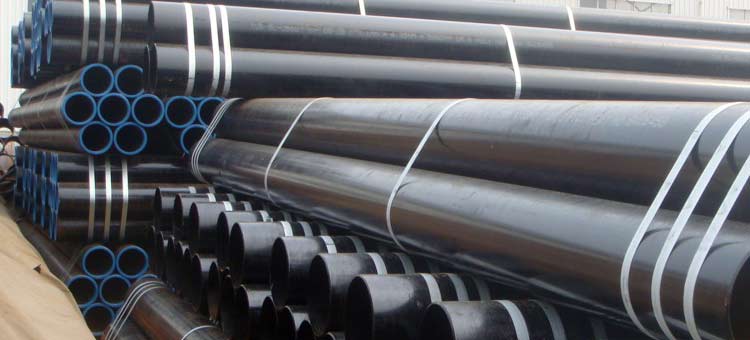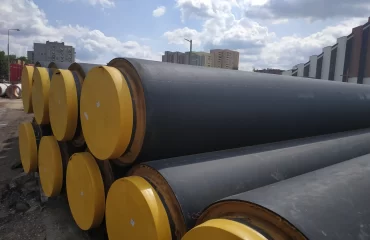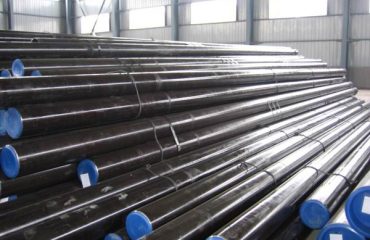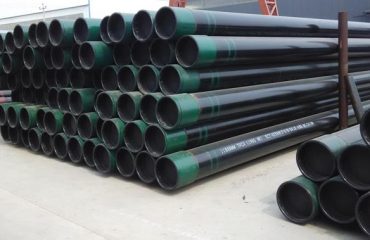
Pengelasan Elektrofusi ASTM A672 (EFW) Pipa Baja
pengantar
ASTM A672 adalah spesifikasi yang mencakup pengelasan fusi listrik (EFW) pipa baja yang dirancang untuk layanan tekanan tinggi pada suhu sedang. Pipa ini biasa digunakan pada industri seperti pembangkit listrik, petrokimia, minyak dan gas, dan transmisi air. Spesifikasi tersebut memberikan pedoman untuk pembuatannya, Pengujian, dan inspeksi pipa baja untuk memastikan pipa tersebut memenuhi sifat mekanik dan persyaratan kinerja yang diperlukan untuk aplikasi tekanan tinggi.
Proses EFW adalah metode pengelasan yang menggunakan busur listrik untuk menyatukan pelat baja, membentuk jahitan memanjang. Proses ini sangat efisien dan menghasilkan pipa dengan integritas struktural dan kekuatan mekanik yang sangat baik. Pipa ASTM A672 tersedia dalam berbagai grade berdasarkan jenis baja yang digunakan dan sifat mekanik yang dibutuhkan.
Artikel ini akan membahas proses pembuatannya, Sifat mekanik, dan aplikasi pipa baja ASTM A672 EFW, serta metode pengujian yang digunakan untuk memastikannya kualitas dan kinerja.
Daftar isi
- Apa itu Pipa Baja ASTM A672 EFW?
- Proses Pembuatan Pipa Baja ASTM A672 EFW
- pengelasan fusi listrik (EFW) Proses
- perawatan panas
- Nilai dan kelas pipa baja ASTM A672
- Sifat mekanik dari ASTM A672 EFW Steel Pipe
- Persyaratan pengujian dan inspeksi
- nondestructive pengujian (NDT)
- Pengujian Hidrostatik
- Aplikasi ASTM A672 EFW Steel Pipe
- Pertanyaan yang Sering Diajukan (Pertanyaan Umum)
- Kesimpulan
Apa itu Pipa Baja ASTM A672 EFW? {#what-is-astm-a672-eFW-steel-pipe}
ASTM A672 adalah spesifikasi standar untuk dilengkapi dengan fusi listrik (EFW) pipa baja yang dirancang untuk layanan tekanan tinggi pada suhu sedang. Pipa -pipa ini dibuat dari bejana tekanan kualitas pelat baja yang dilas fusi menggunakan busur listrik. Spesifikasi ini mencakup pipa dengan jahitan longitudinal dan dimaksudkan untuk digunakan dalam aplikasi di mana kekuatan dan daya tahan tinggi diperlukan.
Fitur Utama dari ASTM A672 EFW Steel Pipe:
-
Fusi listrik dilas (EFW): Pipa diproduksi menggunakan proses EFW, yang melibatkan menggabungkan pelat baja bersama -sama menggunakan busur listrik. Proses ini menghasilkan lasan longitudinal yang kuat yang dapat menahan tekanan tinggi.
-
Pressure Vessel kualitas Baja: Pelat baja yang digunakan dalam pembuatan pipa ASTM A672 berkualitas bejana tekan, artinya mereka dirancang untuk menahan tekanan internal yang tinggi tanpa kegagalan.
-
Layanan Tekanan Tinggi: Pipa ASTM A672 cocok untuk aplikasi bertekanan tinggi, seperti boiler, Penukar Panas, dan jaringan pipa di industri minyak dan gas.
-
Aplikasi Suhu Sedang: Spesifikasi ini mencakup pipa yang dirancang untuk digunakan pada suhu sedang, biasanya sampai 400°C (752° F).
-
Berbagai Kelas: Pipa ASTM A672 tersedia dalam berbagai tingkatan berdasarkan jenis baja yang digunakan dan sifat mekanik yang diperlukan. Nilainya ditentukan oleh komposisi kimia dan perlakuan panas baja.
Proses Pembuatan Pipa Baja ASTM A672 EFW {#proses-pembuatan-pipa-baja-astm-a672-efw}
Pembuatan pipa baja ASTM A672 EFW melibatkan beberapa langkah, termasuk pemilihan pelat baja berkualitas bejana tekan, pengelasan fusi listrik (EFW) Proses, dan perlakuan panas untuk mencapai sifat mekanik yang diinginkan.
pengelasan fusi listrik (EFW) Proses {#proses-pengelasan-fusi-listrik}
Proses EFW adalah jenis pengelasan busur yang menggunakan busur listrik untuk menyatukan pelat baja di sepanjang lapisan memanjang. Prosesnya melibatkan langkah-langkah berikut:
-
Persiapan Piring: Pelat baja pertama-tama dipotong sesuai dimensi yang diperlukan dan diperiksa apakah ada cacat atau ketidaksempurnaan permukaan.
-
Persiapan Tepi: Tepi pelat baja dibuat miring untuk memastikan peleburan yang tepat selama proses pengelasan. Sudut kemiringan dikontrol dengan hati-hati untuk menghasilkan las yang kuat.
-
pengelasan fusi listrik: Pelat diposisikan ujung ke ujung, dan busur listrik digunakan untuk melelehkan tepi pelat, membuat kolam las. Saat busur bergerak di sepanjang jahitan, logam cair menjadi padat, membentuk las kontinu sepanjang pipa.
-
Inspeksi Las: Lasan diperiksa untuk cacat seperti porositas, retak, atau fusi tidak sempurna. Pengujian non destruktif (NDT) metode, seperti pengujian ultrasonik atau pengujian radiografi, sering digunakan untuk memastikan kualitas las.
-
Mengukur dan Membentuk: Setelah pengelasan, pipa dilewatkan melalui serangkaian rol untuk mencapai diameter dan kebulatan yang diinginkan. Pipa juga diperiksa keakuratan dimensinya.
perawatan panas {#perlakuan panas}
Setelah proses EFW, pipa mungkin menjalani perlakuan panas untuk meningkatkan sifat mekaniknya dan menghilangkan tegangan sisa yang disebabkan selama pengelasan. Jenis perlakuan panas tergantung pada kualitas baja dan persyaratan aplikasi. Proses perlakuan panas yang umum meliputi:
-
Normalisasi: Pipa dipanaskan sampai suhu di atas titik kritisnya dan kemudian didinginkan di udara. Proses ini menyempurnakan struktur butiran dan meningkatkan ketangguhan baja.
-
Pendinginan dan Tempering: Pipa dipanaskan sampai suhu tinggi dan kemudian didinginkan dengan cepat (padam) dalam air atau minyak. Kemudian dipanaskan kembali ke suhu yang lebih rendah (marah) untuk meningkatkan keuletan dan ketangguhannya.
-
Menghilangkan Stres: Pipa dipanaskan sampai suhu sedang dan kemudian didinginkan secara perlahan untuk menghilangkan tegangan sisa tanpa mengubah sifat mekanik secara signifikan.
Nilai dan kelas pipa baja ASTM A672 {#pipa baja kelas-dan-kelas-astm-a672}
Pipa baja ASTM A672 tersedia dalam berbagai grade dan kelas berdasarkan jenis baja yang digunakan dan sifat mekanik yang dibutuhkan. Nilainya ditentukan oleh komposisi kimia baja, sedangkan kelas didasarkan pada persyaratan perlakuan panas dan pengujian.
Nilai Umum:
-
Kelas B60: Grade ini terbuat dari baja karbon dengan kekuatan tarik minimal 415 Mpa (60,000 psi). Ini biasanya digunakan untuk aplikasi tekanan sedang.
-
Kelas C65: Grade ini terbuat dari baja karbon-mangan dengan kekuatan tarik minimal 450 Mpa (65,000 psi). Sangat cocok untuk aplikasi bertekanan tinggi.
-
Kelas C70: Grade ini terbuat dari baja karbon-mangan dengan kekuatan tarik minimal 485 Mpa (70,000 psi). Ini digunakan dalam aplikasi tekanan tinggi di mana kekuatan dan daya tahan sangat penting.
kelas:
- Kelas 10: Pipa-pipa pada kelas ini disuplai dalam kondisi as-welded tanpa perlakuan panas apapun.
- Kelas 12: Pipa di kelas ini diberi perlakuan panas setelah pengelasan untuk meningkatkan sifat mekaniknya dan menghilangkan tegangan sisa.
- Kelas 22: Pipa di kelas ini mengalami quenching dan tempering untuk mencapai kekuatan dan ketangguhan yang lebih tinggi.
Spesifikasi Bahan {#spesifikasi bahan}
ASTM A672 pipa terbuat dari pelat baja berkualitas bejana tekan yang dilas menggunakan pengelasan fusi listrik (EFW) Proses. Spesifikasinya mencakup berbagai macam pipa Nilai dan kelas, yang ditentukan oleh Komposisi Kimia dari baja dan perawatan panas diterapkan setelah pengelasan.
Fitur Utama dari ASTM A672 EFW Steel Pipe:
- Fusi listrik dilas (EFW): Pipa dilas menggunakan busur listrik untuk memadukan pelat baja, menciptakan a las memanjang.
- Baja Berkualitas Bejana Tekan: Pelat baja yang digunakan adalah dari kualitas bejana tekan, memastikan pipa dapat bertahan tekanan internal yang tinggi.
- Layanan Tekanan Tinggi: Pipa ASTM A672 dirancang untuk aplikasi bertekanan tinggi di suhu sedang.
- Kelas dan Kelas: Spesifikasinya menyediakan banyak hal Nilai dan kelas berdasarkan Komposisi Kimia dan perawatan panas dari baja.
Tabel Komposisi Kimia {#tabel komposisi kimia}
Komposisi kimia pipa baja ASTM A672 bervariasi tergantung pada Kelas dari baja yang digunakan. Tabel di bawah menguraikan komposisi kimia khas untuk grade umum yang digunakan pada pipa ASTM A672.
| ELEMEN | Kelas B60 (%) | Kelas C65 (%) | Kelas C70 (%) |
|---|---|---|---|
| Karbon (C) | 0.26 max | 0.24 max | 0.23 max |
| mangan (Mn) | 0.98 max | 1.20 max | 1.35 max |
| fosfor (P) | 0.035 max | 0.035 max | 0.035 max |
| sulfur (S) | 0.035 max | 0.035 max | 0.035 max |
| Silicon (Si) | 0.13-0.45 | 0.13-0.45 | 0.13-0.45 |
| kromium (cr) | 0.30 max | 0.30 max | 0.30 max |
| Nikel (Ni) | 0.30 max | 0.30 max | 0.30 max |
| molibdenum (Mo) | 0.12 max | 0.12 max | 0.12 max |
| Tembaga (Cu) | 0.40 max | 0.40 max | 0.40 max |
| vanadium (V) | 0.08 max | 0.08 max | 0.08 max |
Catatan:
- Kandungan Karbon merupakan faktor kunci dalam menentukan Kekuatan dan Kekerasan dari baja. Kandungan karbon yang lebih rendah menjadi lebih baik kemampuan las dan keuletan.
- mangan meningkatkan Kekuatan Tarik dan kemampuan pengerasan dari baja.
- fosfor dan sulfur dijaga pada tingkat rendah untuk mencegah kerapuhan dan meningkatkan ketangguhan.
- Silicon bertindak sebagai a deoksidasi selama proses pembuatan baja dan meningkat Kekuatan.
Tabel Sifat Mekanik {#tabel sifat mekanik}
Sifat mekanik pipa baja ASTM A672 ditentukan oleh Kelas dan Kelas dari pipa, serta perawatan panas diterapkan setelah pengelasan. Tabel di bawah ini memberikan sifat mekanik tipikal untuk pipa ASTM A672 grade umum.
| Milik | Kelas B60 | Kelas C65 | Kelas C70 |
|---|---|---|---|
| Kekuatan Tarik (Mpa) | 415 Min (60,000 psi) | 450 Min (65,000 psi) | 485 Min (70,000 psi) |
| Kekuatan Luluh (Mpa) | 240 Min (35,000 psi) | 275 Min (40,000 psi) | 275 Min (40,000 psi) |
| Elongasi (%) | 22 Min | 22 Min | 22 Min |
| Ketangguhan Dampak (J) | Bervariasi berdasarkan kelas | Bervariasi berdasarkan kelas | Bervariasi berdasarkan kelas |
Catatan:
- Kekuatan Tarik adalah tegangan maksimum yang dapat ditahan material sebelum patah.
- Kekuatan Luluh adalah tegangan dimana bahan mulai berubah bentuk secara plastis.
- Elongasi adalah ukuran keuletan material, menunjukkan seberapa besar ia dapat meregang sebelum putus.
- Ketangguhan Dampak biasanya diukur menggunakan Tes Charpy V-takik, terutama untuk aplikasi di lingkungan bersuhu rendah.
Persyaratan pengujian dan inspeksi {#persyaratan pengujian dan inspeksi}
Untuk menjamin kualitas dan kinerja pipa baja ASTM A672 EFW, beberapa metode pengujian dan inspeksi digunakan selama proses pembuatan. Pengujian ini membantu mengidentifikasi cacat atau ketidakkonsistenan pada material atau las yang dapat membahayakan sifat mekanik atau integritas struktural pipa..
nondestructive pengujian (NDT) {#pengujian-tak rusak-ndt}
nondestructive pengujian (NDT) Metode ini digunakan untuk memeriksa lapisan las dan badan pipa dari adanya cacat tanpa merusak material. Metode NDT yang umum meliputi:
-
Pengujian Ultrasonik (OUT): Gelombang ultrasonik digunakan untuk mendeteksi cacat internal seperti retakan, rongga, atau fusi yang tidak lengkap pada badan las atau pipa.
-
Pengujian Radiografi (RT): Sinar-X atau sinar gamma digunakan untuk membuat gambar lasan, memungkinkan pemeriksa untuk mengidentifikasi cacat internal seperti porositas, inklusi terak, atau retak.
-
Pengujian Partikel Magnetik (MT): Metode ini digunakan untuk mendeteksi cacat permukaan pada bahan feromagnetik. Medan magnet diterapkan pada pipa, dan partikel besi digunakan untuk mengungkap retakan atau diskontinuitas pada permukaan.
-
pewarna pengujian penetran (PT): Pewarna diaplikasikan pada permukaan pipa, dan retakan atau cacat apa pun akan menyerap pewarna, membuatnya terlihat di bawah sinar ultraviolet.
Pengujian Hidrostatik {#pengujian hidrostatik}
Pengujian hidrostatis adalah pengujian kritis yang digunakan untuk memastikan bahwa pipa dapat menahan tekanan internal yang akan dialaminya saat digunakan. Selama tes ini, pipa diisi dengan air dan diberi tekanan hingga tingkat yang lebih tinggi dari tekanan operasinya. Pipa kemudian diperiksa apakah ada kebocoran atau deformasi yang mungkin mengindikasikan kelemahan pada material atau las.
- Tekanan uji: Tekanan uji biasanya 1.5 kali tekanan desain pipa.
- Lamanya: Pipa ditahan pada tekanan uji selama jangka waktu tertentu (biasanya 5 untuk 15 menit) untuk memastikannya dapat mempertahankan tekanan tanpa kegagalan.
Aplikasi ASTM A672 EFW Steel Pipe {#aplikasi-pipa-baja-astm-a672-efw}
Pipa baja ASTM A672 EFW digunakan di berbagai industri dan aplikasi yang mengutamakan layanan tekanan tinggi dan integritas struktural.. Beberapa aplikasi umum termasuk:
-
pembangkit listrik: Pipa ASTM A672 digunakan pada boiler, Penukar Panas, dan pipa uap di pembangkit listrik karena kemampuannya menahan tekanan tinggi dan suhu sedang.
-
industri petrokimia: Pipa-pipa ini digunakan di kilang, tanaman kimia, dan fasilitas petrokimia untuk mengangkut cairan dan gas korosif di bawah tekanan tinggi.
-
industri minyak dan gas: Pipa ASTM A672 digunakan pada pipa minyak dan gas, Platform lepas pantai, dan jaringan pipa bawah laut untuk mengangkut minyak mentah, gas alam, dan hidrokarbon lainnya.
-
Transmisi Air: Pipa-pipa ini digunakan dalam sistem transmisi air untuk mengangkut air minum, air limbah, dan air industri di bawah tekanan tinggi.
-
Aplikasi Struktural: Pipa ASTM A672 digunakan dalam aplikasi struktural seperti kolom, balok, dan penyangga pada bangunan dan struktur industri yang memerlukan kekuatan dan daya tahan.
Pertanyaan yang Sering Diajukan (Pertanyaan Umum) {#Pertanyaan Umum}
1. Apa perbedaan pipa EFW dan ERW?
EFW (Fusi listrik dilas) pipa dilas menggunakan busur listrik untuk menyatukan pelat baja, sementara ERW (Listrik Resistensi Dilas) pipa dilas menggunakan hambatan listrik untuk memanaskan tepi baja dan menyatukannya. Pipa EFW biasanya digunakan untuk aplikasi bertekanan tinggi, sedangkan pipa ERW digunakan untuk aplikasi tekanan rendah hingga sedang.
2. Apa nilai umum pipa ASTM A672?
Nilai umum pipa ASTM A672 termasuk Grade B60, Kelas C65, dan Kelas C70, yang didasarkan pada komposisi kimia dan sifat mekanik baja.
3. Berapa suhu operasi maksimum untuk pipa ASTM A672?
Pipa ASTM A672 dirancang untuk digunakan pada suhu sedang, biasanya sampai 400°C (752° F), tergantung pada grade dan kelas pipa.
4. Bagaimana kualitas pipa ASTM A672 terjamin?
Kualitas pipa ASTM A672 dipastikan melalui pengujian tak rusak (NDT) metode seperti pengujian ultrasonik, Pengujian Radiografi, dan pengujian partikel magnetik, serta pengujian hidrostatis untuk memverifikasi kemampuan pipa dalam menahan tekanan internal.
5. Industri apa yang menggunakan pipa baja ASTM A672 EFW?
Pipa baja ASTM A672 EFW digunakan dalam industri seperti pembangkit listrik, petrokimia, minyak dan gas, dan transmisi air karena kemampuannya menahan tekanan tinggi dan suhu sedang.
Kesimpulan {#Kesimpulan}
Pipa baja ASTM A672 EFW dirancang untuk layanan tekanan tinggi pada suhu sedang, menjadikannya ideal untuk digunakan dalam industri seperti pembangkit listrik, petrokimia, minyak dan gas, dan transmisi air. pengelasan fusi listrik (EFW) proses memastikan las memanjang yang kuat yang dapat menahan tekanan internal yang tinggi, sementara penggunaan baja berkualitas bejana tekan memastikan pipa memiliki sifat mekanik yang diperlukan untuk aplikasi yang menuntut.
Persyaratan pengujian dan inspeksi diuraikan dalam ASTM A672, termasuk pengujian tak rusak dan pengujian hidrostatik, membantu memastikan kualitas dan kinerja pipa, menjadikannya pilihan yang andal untuk aplikasi tekanan tinggi dan struktural.




Kamu harus login untuk mengirim komentar.